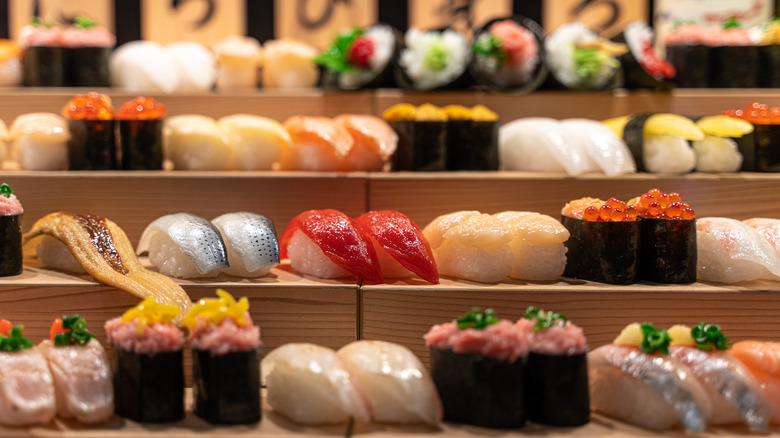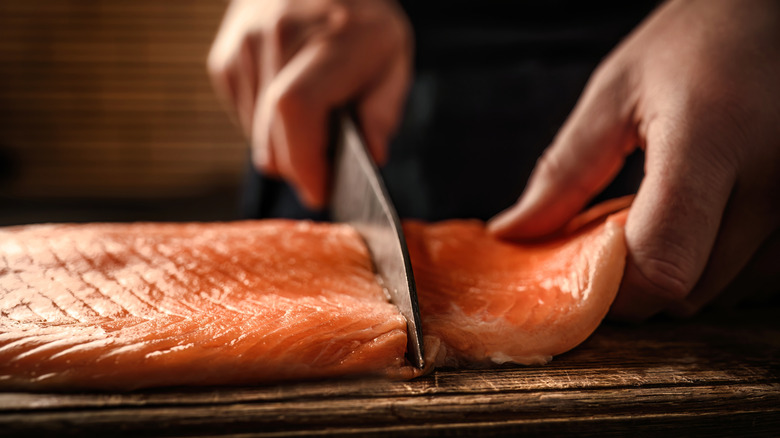What Are Sushi Worms? How To Spot These Terrifying Creatures
Sushi worms are a type of parasite that does not get along well with humans. Starting off as larvae ingested by shellfish, these worms work their way up the food chain as their current hosts get eaten by ever bigger and better hosts — all with the ultimate aim of ending up in the stomachs of marine mammals where they can reproduce.
Sometimes, however, their journey is cut short when they find themselves inside a fish that gets caught for human consumption. Winding up in a human stomach is a dead end for the parasite (whose real name is Anisakis simplex), and it can also be pretty unpleasant for the unwitting human.
As awful as it sounds, sushi worms can reach up to two centimeters in length, which means it is possible to spot them. That said, it wouldn't be advisable to sit in a restaurant and check every piece of sushi before you eat it — instead, you can look out for these sushi restaurant red flags to know if the place you're eating at is respectable or not.
However, if you're buying raw fish for home use, you can give the specimen a once-over with a technique called candling. This involves holding fileted fish up to a light source and visually checking for parasites. If you've got a bad piece of fish, you should be able to spot darker, worm-like shapes within the flesh.
How to avoid sushi worms
Anyone who eats raw or undercooked seafood is at risk of consuming the Anisakis worm, but it's important to note that national food safety standards do account for this. The FDA recommends that all seafood should be frozen at a low enough temperature and for a long enough amount of time to kill parasites like sushi worms, and reputable fish suppliers and restaurants will follow these guidelines. As a result, it's highly unlikely that you'll run into this parasite if you eat at trustworthy restaurants and shop at good-quality stores.
Because sushi worms aren't in control of who eats who, they can end up in a wide variety of fish. Some of the most common culprits include cod, haddock, fluke, pacific salmon, herring, flounder, and monkfish. Along with the FDA's rules on freezing, all the professionals who handle fish during transport and preparation know to keep an eye out for these parasites and remove them on sight.
If you're worried about sushi worms, ask your restaurant or fishmonger for information about their suppliers and the food safety regulations they adhere to, and they should be happy to share (don't be swayed by the label "sushi grade" — it's completely unregulated). This, along with your own observation skills, should be enough precaution to avoid the dreaded Anisakis simplex.
What happens if you ingest sushi worms?
A lot of the time, humans will cough up or vomit out any sushi worms they accidentally ingest — our bodies know those worms are not welcome. In some cases, however, the worms can attach themselves to the walls of the esophagus, stomach, or intestine, and this is known as anisakiasis.
When this happens, it can feel like a bad case of food poisoning, with people experiencing symptoms like nausea, vomiting, and diarrhea. But with no way to survive inside a human, the worm will die after a few days and the symptoms will go away. While unpleasant, it's not a major health risk for humans overall.
It's also not very common, with the U.S. reporting fewer than 10 diagnosed cases each year. Even in Japan, where raw fish is eaten very regularly by a large proportion of the country, annual cases are estimated to be fewer than 20,000.
This might not sound like the smallest number, but since there are around 123 million people in Japan and 365 days in a year, it means only a tiny percentage of sushi-eating sessions end in infection. If you're concerned about sushi worms, make sure to buy fish from reputable sources and keep an eye out for anything wiggly and gross in your fish.


